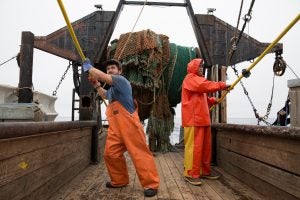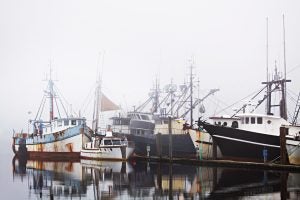
By Dovilė Meliauskaitė
A tool found in corporate boardrooms may soon help future-proof our fisheries.
Climate change presents new challenges to the ocean and the fishermen and fishing communities that rely on healthy ocean ecosystems. In many areas, fishermen are already seeing changes in range and abundance of a variety of species, often well outside of normal fluctuations. And scientists are grappling with making sense of increased ocean acidification, declining dissolved oxygen levels, warmer water and how those changes are affecting productivity, availability and endangered species interactions. New approaches are urgently needed to prepare for climate change impacts on fishing communities and fishery management, including along the U.S. West Coast. The Pacific Fishery Management Council, which manages federal fisheries off the coasts of California, Oregon and Washington, is looking to a novel tool for possible solutions: scenario planning.
What is scenario planning? It’s a process of exploring new ideas, uncovering blind spots and informing decision-making by developing a suite of possible future situations — all to envision and prepare for what the future ecosystem may be like.
The Appeal of Scenario Planning
Climate change means that one thing we can predict with the greatest level of confidence is unpredictability. Under such circumstances, employing tactics invented for more predictable oceans is no longer sufficient. As EDF’s Pathways for Climate-Ready Fisheries report articulates, best practices that stakeholders and governments should consider in preparing for climate change include:
- implementing effective fisheries management and governance;
- strengthening the resilience of entire marine ecosystems;
- building and strengthening international institutions; and
- looking forward and reimagining what fisheries of the future can look like.
The Pacific Fishery Management Council already has strong foundational management practices and is now turning to the fourth pathway — looking forward and reimagining — to develop new approaches.
Predictive scenario modeling to inform decision-making is a tool well-suited for the job. The appeal of scenario planning is that it provides an opportunity for seasoned fisheries experts, practitioners and community stakeholders to escape the limits of their historical practices and frames of reference. Novel perspectives emerge when a variety of informed participants think about the future of their resources, livelihoods and homes together.
“Possible” Over “Most Likely”
One of the cornerstone principles of scenario planning is taking a long-term perspective; in the Pacific Fishery Management Council’s case, they chose 2040 as the target date for thinking about future scenarios. This time horizon releases the pressure of focusing on everyday issues within the organization and creates space to consider factors that affect the world around it. Environmental Defense Fund Oceans members attended a January 2020 PFMC workshop that was kicked off by deep dives into ocean conditions, weather patterns, biological events, inter-species interactions, alternative uses of the ocean, cultural and socioeconomic shifts, as well as other factors affecting the ecosystem. Uncertainty is high when considering such forces over the long run, despite scientific studies providing some insight into what is most likely to happen. But purely scientific perspectives are not always representative of complex social and ecological realities. Scenario planning helps identify our blind spots by inducing a mindset shift: we must break away from the narrow set of the most likely events and consider possibilities that might result from interactions of those events under climate change.
 Value of Scenarios
Value of Scenarios
For example, continued ocean warming could result in range shifts and frequent protected wildlife interactions, which might pressure West Coast fishers to change their fishing gear. Under this scenario, fishery managers might need to accommodate new gear or practices not currently allowed in fishery management plans. Or, based on a variety of factors, the U.S. might decide to adapt its trade policy to protect domestic seafood, radically increase aquaculture protection and restrict foreign imports. With such scenarios in mind, West Coast stakeholders have to consider not only the changes to the fishing industry, but also factors like consumer taste, foreign trade and competing ocean uses. Although these forces are not typically dealt with by fisheries managers, these expert-recognized trends may significantly affect the day-to-day of fisheries management in 20 years.
At the workshop in January, a few dozen such scenarios of potential ecosystem futures on the West Coast were generated. Several common themes have emerged and are being presented at the latest Pacific Fishery Management Council meeting.
Conclusion
The Pacific Fishery Management Council is rightly seeking new ways to move forward and is at the forefront of taking climate change into consideration in fisheries management. Although the scenario planning initiative is just getting underway on the West Coast, hopefully it can offer important lessons for other domestic and international geographies grappling with this issue — as we all begin to think about the far future, beyond just the next year or two.









